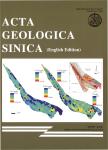Characterization of a Lacustrine Shale Reservoir and the Evolution of its Nanopores: A Case Study of the Upper Cretaceous Qingshankou Formation in the Songliao Basin, Northeastern China
Characterization of a Lacustrine Shale Reservoir and the Evolution of its Nanopores: A Case Study of the Upper Cretaceous Qingshankou Formation in the Songliao Basin, Northeastern China作者机构:State Key Laboratory of Petroleum Resource and ProspectingChina University of PetroleumBeijing 102249China College of GeosciencesChina University of Petroleum.Beijing 102249China National Engineering Research Center of Coal Mine Water Hazard Controlling(Suzhou University)SuzhouAnhui234000China Geological Exploration Technology Institute of Anhui ProvinceHefei 230031China Development and Research CenterChina Geological SurveyBeijing 100037China
出 版 物:《Acta Geologica Sinica(English Edition)》 (地质学报(英文版))
年 卷 期:2020年第94卷第2期
页 面:337-351页
核心收录:
学科分类:081803[工学-地质工程] 0709[理学-地质学] 0819[工学-矿业工程] 08[工学] 0818[工学-地质资源与地质工程] 0708[理学-地球物理学] 0816[工学-测绘科学与技术]
基 金:financial support of Special Scientific Research Project of Public Welfare Industry of Ministry of Land and Resources (Grant No.20121111051) the National Natural Science Foundation of China (Grant No.41272159 and 41572099) supported by Anhui Provincial Natural Science Foundation (Grant No.1908085MD105) China Postdoctoral Science Foundation funded project (Grant No.2019M662200).
主 题:lacustrine shale pore structure pore evolution Upper Cretaceous Songliao Basin
摘 要:The Songliao Basin is one of the most important petroliferous basins in northern China. With a recent gradual decline in conventional oil production in the basin, the exploration and development of unconventional resources are becoming increasingly urgent. The Qingshankou Formation consists of typical Upper Cretaceous continental strata, and represents a promising and practical replacement resource for shale oil in the Songliao Basin. Previous studies have shown that low-mature to mature Qingshankou shale mainly preserves type Ⅰ and type Ⅱ1 organic matter, with relatively high total organic carbon(TOC) content. It is estimated that there is a great potential to explore for shale oil resources in the Qingshankou Formation in this basin. However, not enough systematic research has been conducted on pore characteristics and their main controlling factors in this lacustrine shale reservoir. In this study, 19 Qingshankou shales from two wells drilled in the study area were tested and analyzed for mineral composition, pore distribution and feature evolution using Xray diffraction(XRD), scanning electron microscopy(SEM), low-pressure nitrogen gas adsorption(N2-GA), and thermal simulation experiments. The XRD results show that clay, quartz, and feldspar are the dominant mineral constituents of Qingshankou shale. The clay minerals are mostly illite/smectite mixed layers with a mean content of 83.5%, followed by illite, chlorite, and kaolinite. There are abundant deposits of clay-rich shale in the Qingshankou Formation in the study area, within which many mineral and organic matter pores were observed using SEM. Mineral pores contribute the most to shale porosity;specifically, clay mineral pores and carbonate pores comprise most of the mineral pores in the shale. Among the three types of organic matter pores, type B is more dominant the other two. Pores with diameters greater than 10 nm supply the main pore volume;most are half-open slits and wedge-shaped pores. The total pore volume had no obvious linear relationship with TOC content, but had some degree of positive correlation with the content of quartz + feldspar and clay minerals respectively. However, it was negatively correlated with carbonate mineral content. The specific surface area of the pores is negatively related to TOC content, average pore diameter, and carbonate mineral content. Moreover, it had a somewhat positive correlation with clay mineral content and no clear linear relationship with the content of quartz + feldspar. With increases in maturity, there was also an increase in the number of carbonate mineral dissolution pores and organic matter pores, average pore diameter, and pore volume, whereas there was a decrease in specific surface area of the pores. Generally, the Qingshankou shale is at a low-mature to mature stage with a TOC content of more than 1.0%, and could be as thick as 250 m in the study area. Pores with diameters of more than 10 nm are well-developed in the shale. This research illustrates that there are favorable conditions for shale oil occurrence and enrichment in the Qingshankou shale in the study area.



